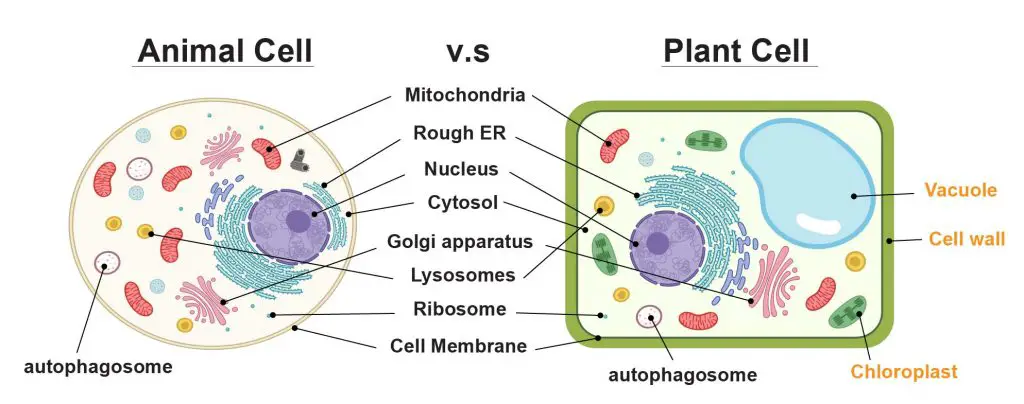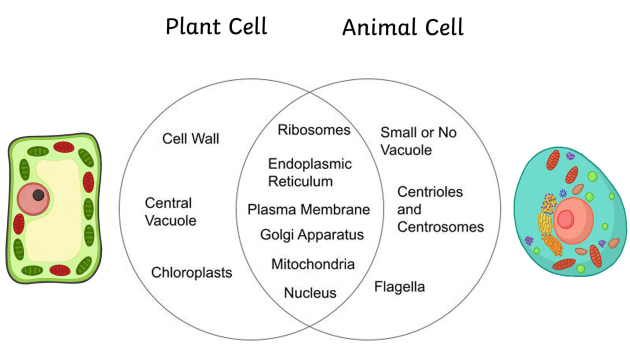70+ Organelles Found In Animal And Plant Cells
Start studying Names and Functions of the Organelles in Plant and animal cells. The central vacuole of some plant cells may occupy 50-90 of the cell volume.

Cell Organelles And Their Functions Rs Science
Animal and plant cells have some of the same cell components in common including a nucleus Golgi complex endoplasmic reticulum ribosomes mitochondria peroxisomes cytoskeleton and cell plasma membrane.

Organelles found in animal and plant cells. Vacuoles in animal cells are much smaller. Simply so what are the main differences between plant and animal cells. Organelles shared by both plant animal cells.
Organelles that are only in animal cells. In animal but not plant cells. Vacuoles are storage sacs for solid or liquid contents.
Membrane-bound organelles such as the nucleus mitochondria endoplasmic reticulum golgi apparatus lysosomes and peroxisomes. They both contain membrane-bound organelles such as the nucleus mitochondria endoplasmic reticulum golgi apparatus lysosomes and peroxisomes. It confers shape and rigidity.
Discuss these differences in relation to the activities of plants and animals. Protects the cell from osmotic swelling. Transport of materials within the cytoplasm.
Rough Smooth Endoplasmic Recticulum. Through how many membranes would a molecule have to pass in going from the interior of a chloroplast to the interior of a mitochondrion. 808 views There was an error loading more items.
Processes packages and distributes proteins to other organelles for export. Large vacuoles are common in plant cells. Contains the genes chromatin.
Learn vocabulary terms and more with flashcards games and other study tools. Mitochondria Cell Wall Cytoplasm. Their primary function is to -.
Structurally plant and animal cells are very similar because they are both eukaryotic cells. Both also contain similar membranes cytosol and cytoskeletal elements. Organelles are found in Eukaryotic cells and are tiny structures inside cells that carry out different functions to insure that homeostasis is maintained.
In animals the centriole is present and. Facilitates the movement of organelles. Vacuoles are round organelles found in both plant and animal cells.
Processes packages and distributes proteins to other organelles for export. Plant cells contain all of the same organelles as animal cells including mitochondria a nucleus ribosomes smooth and rough ER Golgi apparatus lysosomes peroxisomes cytoplasm and a cell membrane. Are they Plant animal or both plant and animal cells.
Learn with flashcards games and more for free. Which set of organelles are found in all three types of cells. Structural support of cells.
Plant cells and animal cells both are eukaryotic cells that contain a nucleus and other organelles to perform necessary functions but the clear difference between them is the lack of cell wall vacuoles and chloroplast in the animal cell and the absence of. While animal and plant cells. Ribosome Cell Membrane Vacuole.
Rough endoplasmic reticulum RER. However they also contain some subcellular structures that are absent in animal cells such as chloroplasts a vacuole and a cell wall. In plant cells vacuoles are full of cell sap and provide turgidity swollen and distended or congested and rigidity to the cell.
31 Animal Cell Central Vacuole
The vacuoles membrane is mainly made up of phospholipids. Why are plant cell vacuoles many and in animal cells have only one big central vacuole.
What Is The Function Of A Vacuole In An Animal Cell Quora
A vacuole is an organelle inside plant and animal cells that stores water and some wasteAn animal has small vacuoles which are barely more than large vesicl.

Animal cell central vacuole. Animal vacuoles store nutrients ions and water. While animal have several small vacuoles plants have one or fewer large big central vacuole Correcting your question. Animal cell diagram labeled vacuole.
Its one of the largest organelles found in cells and its shaped like a large sac. The vacuole is a type of organelle present in eukaryotic cells. The main function of vacuoles in animal cells is to isolate and remove waste products from the other organelles and the cytoplasm.
In animal cells the main job of the vacuole. Which of the following is a function of the central vacuole. Choose two of these structures and explain why each of these is useful for plant cells but not needed or even a disadvantage for animal cells.
Plant vs animal cells diagram. Vacuoles have a simple structure. Although animal cells contain vacuoles they do not contain large central vacuoles.
Plant cells have several structures that are not found in animal cells - chloroplasts cell walls and central vacuoles. Cellcell wall a cell p label. In animal cells vacuoles are generally small and help sequester waste products.
Animal cells each have a centrosome and lysosomes whereas plant cells do not. Plant cells dont have cholesterol in. Storing the genetic information of the cell Converting light energy to chemical energy Working with mRNA to synthesize proteins Separating the cell from its surroundings Storing compounds produced by the cell.
The main difference between plant and animal vacuoles is that plant vacuoles are large in size and are single in number whereas animal vacuoles are small in size and are more in number. Its central vacuoles lose waterair and the cells subsequently lose their turgor pressure which causes them to lose their shape. There are vacuoles that exist in freshwater fish and other organisms that are similar and these are called contractile vacuoles These vacuole types contract and extend to release the excess water that is brought into the body during feeding.
In animal cells vacuoles tend to play a lesser role. The contractile vacuole is a specialized type of vacuole. A vacuole is a structure found in animal plant bacteria protist and fungi cells.
It is a sac surrounded by a single membrane called a tonoplast. Vacuoles in animal cells however tend to be much smaller and are more commonly used to temporarily store materials or to transport substances. One of the main differences between plants and animal cells is the vacuole volume.
In animal cells they are small and typically transport materials into and out of the cell. They are surrounded by a thin membrane and filled with fluid and any molecules they take in. Vacuoles in both plant and animal cells serve as storage organelles inside the cell.
Cell wall chloroplast central vacuole. This diagram of a plant cell shows the central vacuole in blue. It contain fluid called cell SAP which consists of water sugar amino acids in Science salt nitrogenous waste etc.
Vacuoles serve many functions depending on the needs of the cell. Plant cells have a cell wall chloroplasts and other specialized plastids and a large central vacuole whereas animal cells do not. It becomes larger as the cell grows.
Sometimes a single vacuole can take up most of the interior space of the plant cell. Initially the vacuole is like a small bubble. In plant cells vacuoles help maintain water balance.
Vacuoles in a single-celled organism such as the amoeba are responsible for digestion of the food that they engulf. The central vacuoles also give the cells turgor pressure when full. Many plant cells have a large single central vacuole that typically takes up most of the room in the cell 80 percent or more.
A vacuole is a membrane-bound cell organelle. Nucleus Transparent Animal Cell Vacuole In A Cell Diagram Free Transparent Clipart Clipartkey See vacuole stock video clips. Vacuoles are storage sacs or cavities in which solid or liquid is stored in the cell.
Thats why if you dont water a plant it begins to wilt.
58+ Animal Cell Organelles And Their Functions Chart
14 rows Cell Organelles. Almost all animals and plants are made up of cells.

Cell Organelle Organelles Structure Functions Videos And Examples
Separates the cell from its environment.

Animal cell organelles and their functions chart. Controls what enters and exits the kennel in order to keep dogs in and unwanted intruders out. Organelle Animal andor Plant Function 1. Suspends and holds a cells organelles such as the nucleus.
Cell membrane nucleus nucleolus nuclear membrane cytoplasm endoplasmic reticulum Golgi apparatus ribosomes mitochondria centrioles cytoskeleton vacuoles and vesicles. Cell Organelles and Their Functions - Refer to pages 12 13 and fill in the following table for each of the components or organelles of the cell. Lets take an example of ribosome organelle which does the main function of protein production.
Centrioles are about 500nm long and 200nm in width that are found close to the nucleus and helps in cell division. Boundary that separates the cell from its environment Large oval structure Mitochondria Rod shaped structures Chloroplasts Large green structures The powerhouses of the cell mighty mitochondria convert energy in food molecules into energy the cell can use Capture energy from sunlight and use it to produce food for the cell Ribosomes Small grain-like bodies Produce proteins which are passed through the ER to the Golgi Bodies and throughout cell Lysosomes Animal. CELL STRUCTURE AND FUNCTION CHART PLANT CELL ANIMAL CELL.
They are also found in cilia and flagella. Some further research may be required. Characteristics of eukaryotic cells.
10 rows Centrioles Animal cells paired structures near the nucleus made of cylinder of microtubule. Regulates the movement of materials in and out of the cell. Animal cells have a basic structure.
8 Smooth endoplasmic reticulum SER. Animal cell functions and organelles are linked to each other. Animal cell diagram detailing the various organelles Though this animal cell diagram is not representative of any one particular type of cell it provides insight into the primary organelles and the intricate internal structure of.
Endoplasmic reticulum and golgi apparatus. A double membrane composed of lipids. This is the currently selected item.
15 rows The animal cell and plant cell share many organelles in common such as a nucleus ER. Parts of the animal cell structure. They are paired tube-like organelle composed of a protein called tubulin.
Below the basic structure is shown in the same animal cell on the left viewed with the light. Cellular organelles and structure. Centrioles Animal Cells Only Play a role in cell division.
Lysosomes are the digestive organelles of animal cells. Photosynthesis takes place in chloroplasts. 5 Rough endoplasmic reticulum RER.
Epithelial and connective tissue. Substance that fills inside of cell and supports all of the organelles within the cell. Plant cells have a cell wall chloroplasts and a central vacuole.
Main parts of an animal cell. Controls what enters and exits the cell in order to maintain balance within the cell. 11 Cytosol Its not an organelle.
The various cell organelles present in an animal cell are clearly marked in the animal cell diagram provided below. View animal cell diagramdocx from sat phy prep j2 at stiftung louisenlund. Found in the center of cell in animals it is off to the side 8.
Animal cell structure animal cells have a variety of different organelles that work together to allow the cell to perform its functions. It is elastic living double layer and permeable membrane. 6 Golgi apparatus.
The plant cell wall whose primary component is cellulose protects the cell provides structural support and gives shape to the cell. In fact the collective work of the animal cell parts is responsible for overall functioning of the cell. The nucleus contains all of the genetic material in a cell.
